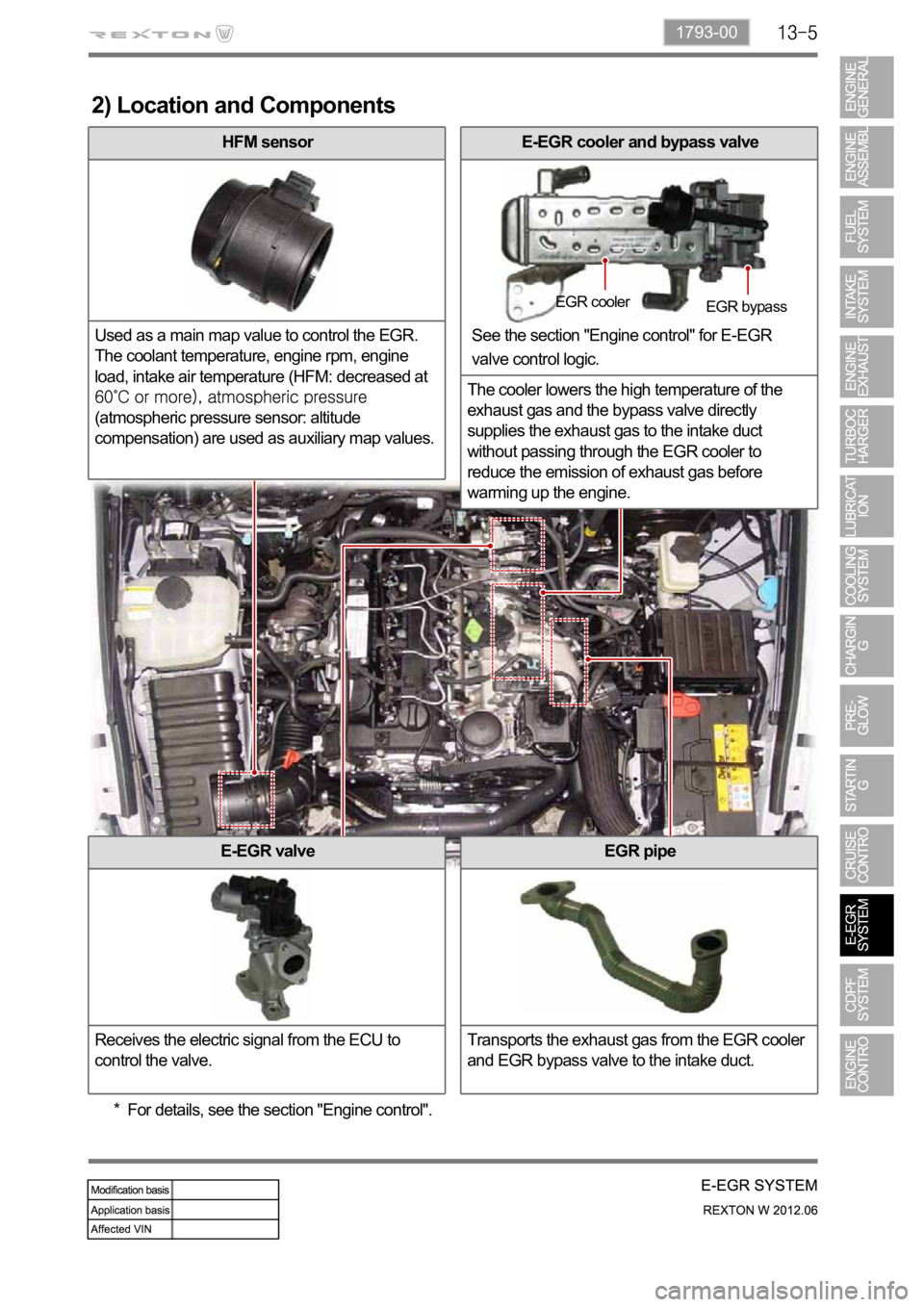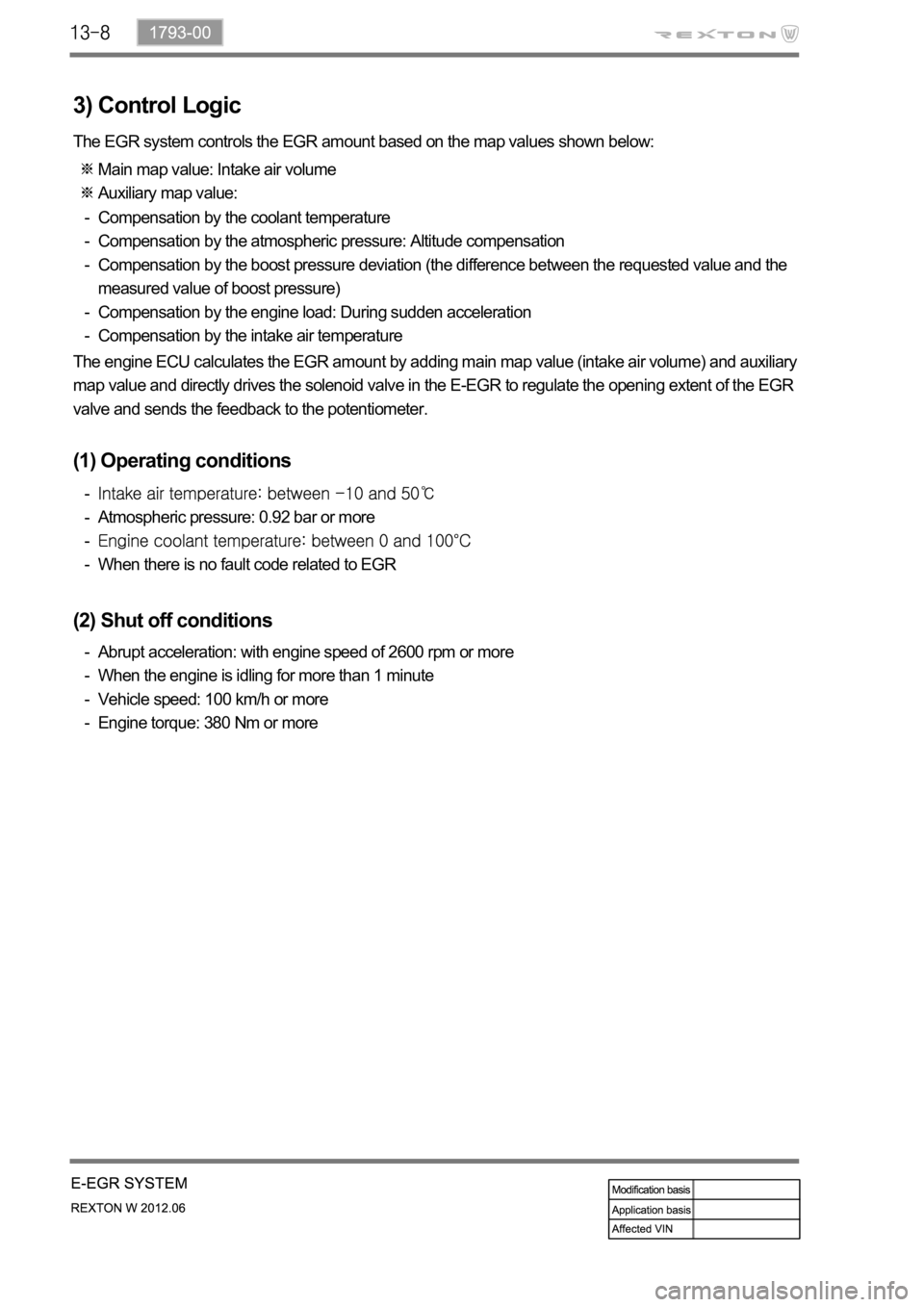ECU SSANGYONG NEW REXTON 2012 Owner's Guide
[x] Cancel search | Manufacturer: SSANGYONG, Model Year: 2012, Model line: NEW REXTON, Model: SSANGYONG NEW REXTON 2012Pages: 600, PDF Size: 73.29 MB
Page 402 of 600

1413-00
During cranking: Step 2 and step 3
Step 2: If the ECU receives the cranking signal after pre-heating (step 1), the GCU supplies the 1.
2.
Under fixed temperature: The AQGS unit supplies power for 30 seconds (Step 1 + Step 3)
if no cranking signal is received after the step 1.
At cranking: The step 3 is started after the step 2. *
*
Post-glow: Step 4:
The post-heating is for reducing HC/CO after the engine is started. If the time for post-heating exceeds
180 sec., the GCU unit cuts off the power to each glow plug even if there is pre-heating request from the
engine ECU.
Emergency glow
If no CAN signal is received for 4 seconds from the engine ECU after the IGN ON signal is input, the
GCU performs emergency preheat (Step 3) for 30 seconds.
Post-heatingOperating time
(approx.)
Operating time
(approx.)100 s 50 s 25 s 10 s 10 s
Page 411 of 600

8510-23
2. CONFIGURATION
1) Circuit Diagram
The engine ECU detects the operating conditions of cruise control system, and monitors the braking
performance, vehicle speed, road conditions and ESP system operation. If the engine ECU determines
that there are not any problem to drive in cruise control mode, the vehicle can be operated by cruise
switch signals (decelerating, accelerating, cruising).
Page 420 of 600

1. SYSTEM DESCRIPTION
1) Overview
The EGR (Electric-Exhaust Gas Recirculation) valve reduces the NOx emission level by recirculating
some of the exhaust gas to the intake system.
To meet Euro-V regulation, the capacity and response rate of E-EGR valve in D20DTR engine have been
greatly improved. The EGR cooler with high capacity reduces the Nox, and the bypass valve reduces the
CO and HC due to EGR gas before warming up.
Also, the engine ECU adjusts the E-EGR opening by using the air mass signal through HFM sensor. If
the exhaust gas gets into the intake manifold when the EGR valve is open, the amount of fresh air
through HFM sensor should be decresed.
Benefits of E-EGR valve
Improved accuracy and response through electric control
Feedback function (Potentiometer)
Preventing chattering of EGR valve and improved durability
Self-cleaning function -
-
-
-
Page 421 of 600

1793-00
E-EGR valve
Receives the electric signal from the ECU to
control the valve.
E-EGR cooler and bypass valve
The cooler lowers the high temperature of the
exhaust gas and the bypass valve directly
supplies the exhaust gas to the intake duct
without passing through the EGR cooler to
reduce the emission of exhaust gas before
warming up the engine.
2) Location and Components
HFM sensor
Used as a main map value to control the EGR.
The coolant temperature, engine rpm, engine
load, intake air temperature (HFM: decreased at
(atmospheric pressure sensor: altitude
compensation) are used as auxiliary map values.
EGR pipe
Transports the exhaust gas from the EGR cooler
and EGR bypass valve to the intake duct.
See the section "Engine control" for E-EGR
valve control logic.
EGR cooler
EGR bypass
For details, see the section "Engine control". *
Page 424 of 600

3) Control Logic
The EGR system controls the EGR amount based on the map values shown below:
Main map value: Intake air volume
Auxiliary map value:
Compensation by the coolant temperature
Compensation by the atmospheric pressure: Altitude compensation
Compensation by the boost pressure deviation (the difference between the requested value and the
measured value of boost pressure)
Compensation by the engine load: During sudden acceleration
Compensation by the intake air temperature -
-
-
-
-
The engine ECU calculates the EGR amount by adding main map value (intake air volume) and auxiliary
map value and directly drives the solenoid valve in the E-EGR to regulate the opening extent of the EGR
valve and sends the feedback to the potentiometer.
(1) Operating conditions
Atmospheric pressure: 0.92 bar or more
When there is no fault code related to EGR -
-
-
-
(2) Shut off conditions
Abrupt acceleration: with engine speed of 2600 rpm or more
When the engine is idling for more than 1 minute
Vehicle speed: 100 km/h or more
Engine torque: 380 Nm or more -
-
-
-
Page 427 of 600

2412-02
The CDPF system enters the regeneration mode
when the driving distance becomes approx. 600
to 1,200 km (may differ by the driving condition
and driving style). Then, the engine ECU
performs the CDPF regeneration operation.
However, the driver is not informed with this
operation by any engine warning lamp or vehicle
signal, so he/she may not detect this operation.
The control logic at the post-injection dur-ing the
regeneration process is to increase the fuel
injection volume and control the intake air volume
(by the throttle body) in order to increase the
temperature of the exhaust gas. The driver may
not feel any particular difference from the vehicle.
Overload of CDPF (warning lamp blinking)
(3) Warning Lamp Related to CDPF
CDPF regeneration process (warning lamp NOT illuminated)
If the CDPF cannot reach the regeneration temperature due to low speed driving or other reason
during the regeneration process, the soot is continuously accumulated in the CDPF. When this
condition continues and the CDPF is overloaded with soot, the engine warning lamp blinks to inform
this situation to the driver.
In order to solve this problem, drive the vehicle at a speed of approx. 80 km/h for 15 to 20 minutes to
perform the CDPF regeneration process.
If the engine warning lamp on the instrument cluster blinks, the CDPF is overloaded. In this case,
perform the step 2. 1.
2.
3.
Turned off
Blinking
Page 430 of 600

Differential pressure
sensor
Calculates the amount of
PM collected by reading the
pressure difference between
before and after the CDPF.Engine ECU
DCM 3.7
Post-injectionThrottle
valve
Regulates the rate of air
intake.
CDPF
DOC+DPFFront temperature
sensor
Protects the turbocharger.Rear temperature sensor
Measures the temperature
of fuel combustion.
2. COMPONENT
For details, refer to section "Engine Control". *
Page 433 of 600

2412-02
Front temperature sensor
Measures the temperature of
exhaust gas.
This sensor is located at the rear
side of exhaust manifold and
monitors the temperature of
combusted gas to prevent the
exhaust system from overheating.
When the temperature gets higher,
this sensor cuts off the fuel delivery
and controls the EGR to lower the
temperature.Rear temperature sensor
Measure the outlet
temperature of DOC.
This sensor is located at the
rear side of DOC and
monitors the overheating of
CDPF and post injection
volume.
Engine ECU (D20DTR)
Differential pressure sensor
Measures the difference between
inlet and outlet pressures of CDPF.
If the difference is higher than the
specified value when collecting the
PM, this makes the post injection for
forced recycling of PM.
T-MAP sensorIntake air
mass
Measures
the
excessive
amount of
PM.
Boos
t
pressure
/
temperature
Injector (C31)
Controls the post injection.
Electric throttle body
Controls the intake air mass.
HFM sensor
Wide band
oxygen senso
r
Page 434 of 600

Collecting PM
The engine ECU detects the
amount of PM collected by the
information from the
temperature sensors and
differential pressure sensor.
When the soot is accumulated,
the engine ECU performs post-
injection to increase the
exhaust gas temperature and
burns the collected PM at
Oxidation (DOC)
When the exhaust gas enters
into the CDPF assembly, its
CO, HC and PM are reduced
by the redox reaction of the
DOC. The remaining PM is
filtered and collected in CDPF,
and the temperature of the
exhaust gas is increased to
5. OPERATING PROCESS
[Configuration and principle of operation]
The exhaust gas
passed through the
exhaust manifold
enters into the CDPF
assembly (at approx
Page 436 of 600

2) Collecting PM of DPF
There is a filter installed in the DPF and the PM filtered by this filter is burned (regeneration) when the
temperature of exhaust gas is increased due to post-injection. The filter has a honeycomb-like structure
to capture the particulate matter and the inlet and outlet of each channel are closed alternatively. Once
the exhaust gas enters to the inlet of a channel, it is released from the outlet of the adjacent channel
through the porous wall because of the closed outlet of the first channel, and the PM is collected in the
first channel.
[Collecting PM of CDPF]
Normally, when the driving distance becomes approx. 600 to 1,200 km, enough amount of soot to
be burned is filtered and accumulated in the CDPF. The ECU increases the amount of fuel post-
burned. The soot is burned for 15 to 20 minutes (may differ by conditions).